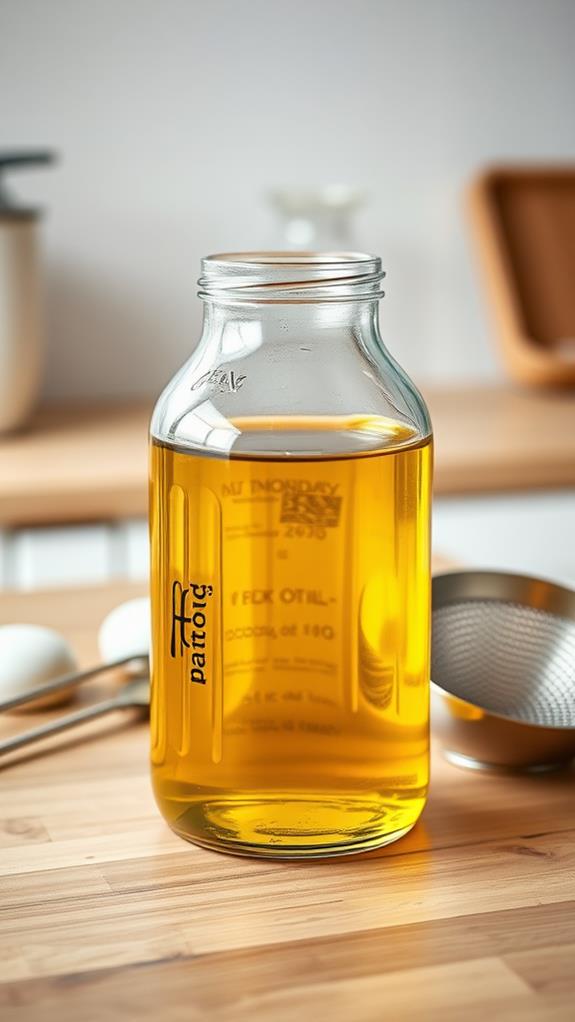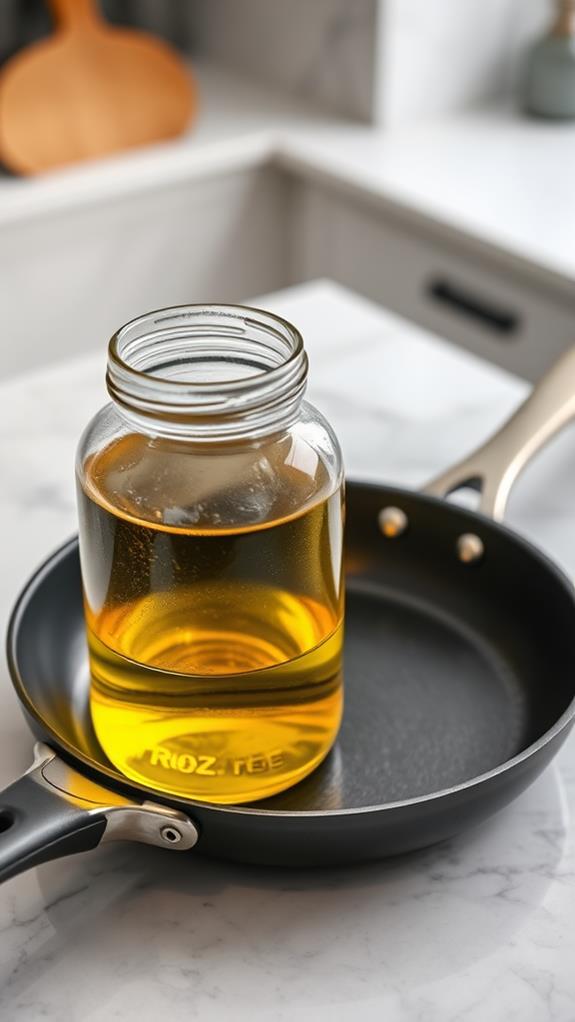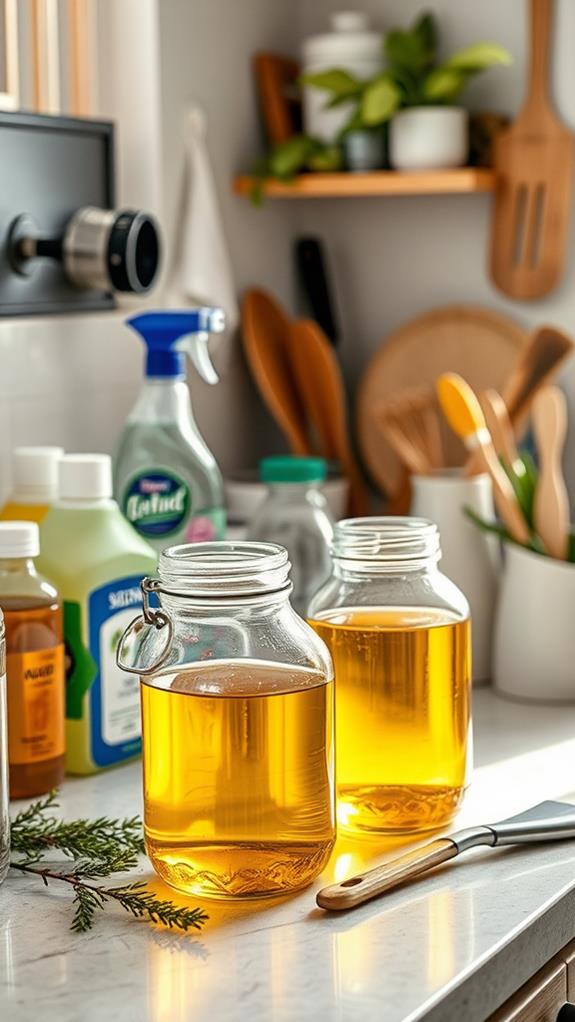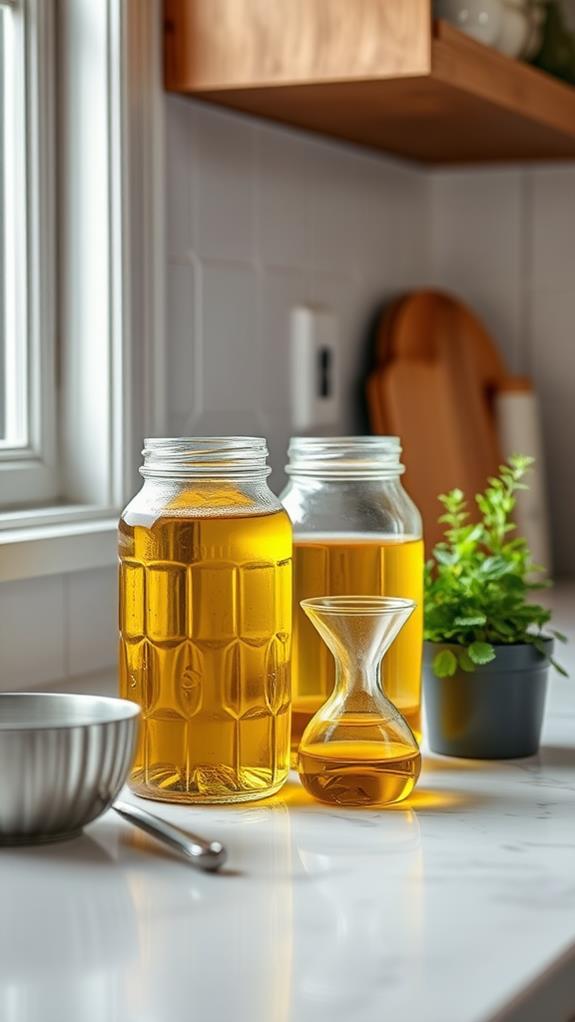What to Do With Leftover Frying Oil
When you're done frying, don't toss that oil just yet. First, let it cool completely to prevent burns. Then, strain it through a fine-mesh sieve lined with cheesecloth to remove food particles. Store the oil in an airtight glass container, labeled with the type and date used. You can reuse it for frying up to three times, keeping it refrigerated between uses. Alternatively, repurpose it for non-food uses like making soap or biodiesel. If you must dispose of it, seal it in a container and check with your local recycling center for proper disposal methods. There's more to discover about maximizing your leftover frying oil.
This post may contain affiliate links. If you make a purchase through these links, I may earn a commission at no additional cost to you. Additionally, portions of this post may be generated using artificial intelligence (AI) technology. While we strive for accuracy, please be aware that AI-generated content may not always be perfect and should be fact-checked when necessary.
The Spatula Scoops
- Strain cooled oil through a fine-mesh sieve lined with cheesecloth to remove food particles.
- Store strained oil in an airtight glass container, labeled with oil type and date used.
- Reuse the oil for frying up to three times, adding fresh oil when needed.
- Repurpose cooled oil for non-food uses like making soap, candles, or biodiesel fuel.
- Dispose of small amounts in sealed containers with regular trash or recycle at local centers.
Cooling and Straining Methods

When you're done frying, you'll need to know how to properly handle your used cooking oil. Safety should be your top priority, so always allow the oil to cool completely to room temperature before attempting to clean or strain it. This cooling process helps prevent accidental burns, which can be severe with hot oil.
Once your oil has cooled, it's time to strain it. You'll want to remove any food particles or debris left from the frying process. To do this effectively, pour the oil through a fine-meshed sieve lined with cheesecloth. This method ensures that even tiny bits of food are filtered out, which is indispensable for maintaining the oil's quality for future use. For ideal results, consider using a set of high-quality mesh strainers with varying sizes to accommodate different volumes of oil. These strainers are typically dishwasher safe, making cleanup a breeze.
Why is straining so important? Those small food particles can lead to off-flavors when you reheat the oil. Plus, straining as soon as possible after use helps preserve the oil's integrity. After straining, you can transfer the clean oil to a suitable container or bottle for storage. Remember, proper handling of used frying oil not only extends its usability but also makes disposal easier when the time comes.
Proper Storage Techniques

Storing your used cooking oil correctly is crucial for maximizing its lifespan and ensuring it's safe for future use. To properly store the oil, you'll want to bottle it in an airtight container, such as a glass jar. This helps prevent oxidation and contamination. Once you've bottled the oil, place it in a cool, dark place to extend its shelf life. You can even refrigerate or freeze the used oil to slow down the oxidation process and prevent it from going rancid. For smaller portions of oil, consider using glass prep bowls with lids, which are perfect for storing and organizing various kitchen ingredients.
- Choose an airtight container, preferably a glass jar
- Label the container with the type of oil and date used
- Store in a cool, dark place away from heat sources
- Consider refrigerating or freezing for longer storage
When storing your used oil, avoid placing it near heat sources like your oven or stove, as heat can accelerate deterioration. To maintain quality and extend reusability, you can add a small amount of fresh oil to the used oil. By following these storage techniques, you'll be able to safely reuse your cooking oil and reduce waste in your kitchen.
Reusing Frying Oil Safely

Four key steps can help you safely reuse your frying oil. First, you'll need to strain the oil through a fine mesh sieve lined with cheesecloth. This removes any food particles that could spoil the oil. Once the oil cools completely, pour it into a sealable container for storage. While vegetable oils are commonly used for frying, corn syrup alternatives like light agave syrup can also be used in some cooking applications.
Next, store your strained oil in the refrigerator. This helps preserve its quality, allowing you to reuse oil for up to three months. When you're ready to fry again, consider adding some fresh oil to the old oil. This practice helps maintain the oil's quality and extends its usability.
Alternative Uses for Oil

The quick brown fox jumps over the lazy dog. The dog then chases the fox. However, the fox is too fast and escapes. When you're done with your deep fryer and want to dispose of frying oil, don't just toss it out. There are several alternative uses for leftover frying oil that can be both eco-friendly and practical. You can reuse cooking oil in various ways, even after it's been used for fried foods.
Here are some creative ways to use this handy resource:
- Convert it into biodiesel fuel
- Create a nutritious bird food mixture
- Make homemade soap
- Use it for a moisturizing bath
Before you repurpose your oil, allow the oil to cool completely after it reaches frying temperature. Once cooled, strain it to remove any food particles. If you plan to reuse the oil for cooking, label the container with the date and type of food fried. For non-cooking uses, consider the oil's condition. Rancid oil works well for soap-making, while fresher oil is better for biodiesel conversion. Remember, these alternative uses help you dispose of cooking oil responsibly while reducing waste.
Environmentally-Friendly Disposal Options

When it's time to dispose of your used cooking oil, several environmentally-friendly options exist. First, consider cooling the oil completely before handling it. Once cooled, you can transfer small amounts into a disposable container and place it in your regular trash. For larger quantities, check if your local recycling center accepts used frying oil. Many facilities collect it for conversion into biodiesel or other products.
Another option is to pour the cooled oil into a sealable container and dispose of it in your food waste bin, if your area offers this service. Some communities have specific collection points for used cooking oil, so research local resources. Remember, you should never pour oil down the drain, as it can solidify and clog your pipes or damage the sewer system.
If you're feeling creative, you can reuse the oil for non-food purposes. Consider making homemade soap or candles, or use it as a lubricant for garden tools. By exploring these environmentally-friendly disposal methods, you can safeguard that your used frying oil doesn't harm the ecosystem while potentially giving it a second life.
Frequently Asked Questions
What Do You Do With Leftover Oil After Deep Frying?
After deep frying, you'll want to handle your leftover oil properly. First, let it cool completely. Then, strain it through a fine-mesh sieve or cheesecloth to remove any food particles. You can reuse the oil a few times if it's not too dirty or smelly. When it's time to discard, pour it into a sealed container and dispose of it in the trash. Don't pour it down the drain, as it can clog pipes and harm the environment.
How to Dispose of Oil After Frying?
To dispose of oil after frying, first let it cool completely. Don't pour it down the drain, as it can clog pipes and harm the environment. Instead, seal the cooled oil in a leak-proof container and place it in the trash. You can also mix it with absorbent materials like kitty litter to solidify it before disposal. Check with your local authorities for specific guidelines or recycling programs. Remember, proper disposal helps protect your plumbing and the environment.
What Can I Do With Leftover Grease and Oil?
Did you know that the average American household produces about 9 pounds of used cooking oil annually? You've got options for your leftover grease and oil. You can reuse it for cooking, but strain it first. Consider using it as a lubricant for tools or door hinges. It's also great for making homemade bird feeders. If you're crafty, you can make soap or candles. For disposal, never pour it down the drain; instead, cool it, seal it in a container, and throw it in the trash.
What Can I Do With Leftover Oil From Oil Change?
Don't pour your used motor oil down drains or onto the ground. It's harmful to the environment. Instead, you should take it to an auto parts store or recycling center that accepts used oil. They'll make certain it's properly recycled or disposed of. This helps protect soil and waterways from contamination. Many places will even refine the oil for reuse, which reduces the need for new oil production. Remember, proper disposal is vital for safeguarding ecosystems and wildlife.





